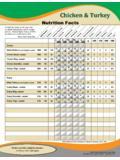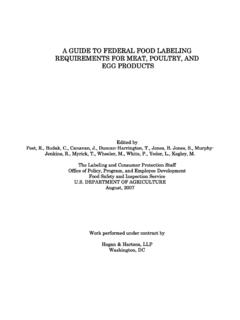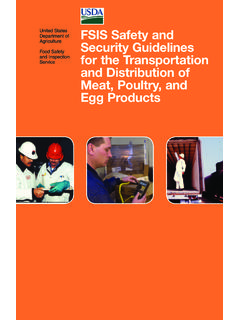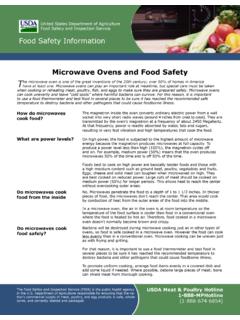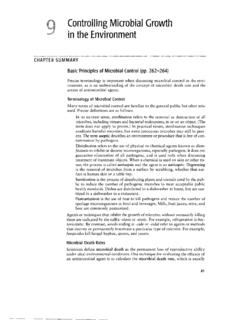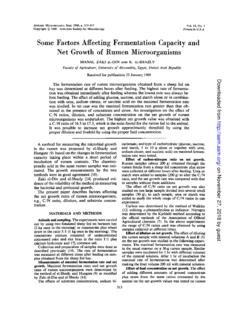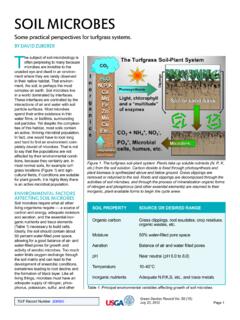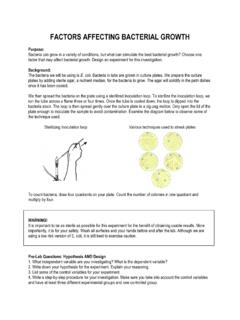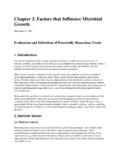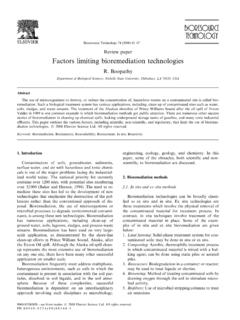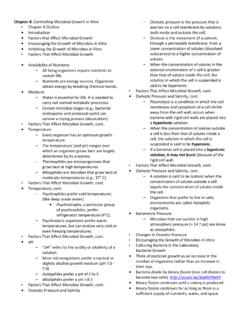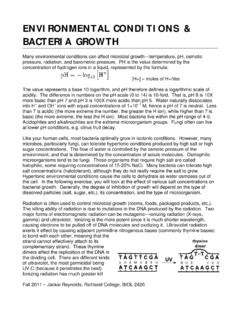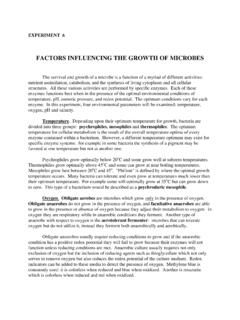Transcription of Fundamental Food Microbiology - USDA Food Safety and ...
1 food Microbiology 09/12/12 Inspection Methods 1 Fundamental food Microbiology Objectives 1. Identify the basic types of microbes. 2. Describe the typical bacterial growth pattern, and explain important factors affecting microbial growth . 3. Describe basic mechanisms and indications of microbial food spoilage. 4. Describe how certain microbes are be used in food preservation. 5. List important pathogens of concern in meat and poultry products. 6. Describe sources of microbes in meat and poultry products. 7. Identify specified risk materials. 8. Explain Fundamental methods of controlling microbial contamination of meat and poultry. Introduction Microbiology is a specialized area of biology dealing with organisms too small to be seen without sufficient magnification. Microbiologists study bacteria, fungi, parasites, viruses, and prions and their interactions with humans, animals, plants, and the environment.
2 While viruses and prions are not living organisms like bacteria, fungi, and parasites, they are studied by microbiologists; therefore, we will use the term microbe to collectively refer to any of these biologically active and microscopic entities. food Microbiology is specifically concerned with the desirable and undesirable effects microbes can have on the quality and Safety of food products. In this section, we will briefly survey the importance of microbes in food . We will overview some Fundamental microbiological concepts and consider how microbes are involved in food spoilage, food preservation, and foodborne illness. We will conclude by considering the sources of microbes and general ways in which microbes may be controlled in food and food processing environments. Types of Microbes Bacteria Bacteria are small, single-celled organisms that occur in almost any natural environment.
3 Common bacteria are too small to be seen individually without the aid of a microscope Bacteria can multiply to form groups or colonies on a food source. After a food Microbiology 09/12/12 Inspection Methods 2 sufficient number of replication cycles a colony of bacteria can be seen with the naked eye. Viewed under a microscope, different kinds of bacteria will have different shapes or forms. Many bacteria have either a spherical shape or an elongated rod shape. A spherical shaped bacterium (singular) is called a coccus, and spherical-shaped bacteria (plural) are called cocci. A rod shaped bacterium is called a bacillus, and rod-shaped bacteria are called bacilli. Some types of bacteria appear as individual or solitary cells microscopically. Some bacteria will combine to form pairs ( , diplococci), groups of four (tetrads), grape-like clusters ( , staphylococci), and chains ( , streptococci or streptobacilli).
4 Many bacteria have projections from their cell walls called fimbriae. These structures assist those bacteria in attaching to one another as well as to other surfaces. Some bacteria also possess flagella that allow those bacteria to be motile. Certain bacteria ( , Clostridum spp.) have the capacity to sporulate or form spores (or endospores). Simply put, a spore-forming bacterium encapsulates its vital structures in a tough outer coat when environmental conditions become harsh. As spores the bacteria are extremely resistant to heat, chemicals, and other environmental conditions. In the spore form, these bacteria are unable to reproduce; however, once conditions become favorable for growth they can reactivate and become vegetative (reproducing) cells again. Some bacteria can produce toxins that in sufficient doses cause foodborne illness ( , botulism).
5 Toxins can be produced by spore-forming bacteria, but only in the vegetative state. Some non-spore forming bacteria, like Staphylococcus aureus, can also produce toxins. Fungi The fungi consist of two major groups of microbes, molds and yeasts. Molds are multi-cellular organisms. Yeasts are single-celled organisms. Molds and yeasts tend to be significantly larger than bacteria. Both molds and yeasts are widely distributed in nature, both in the soil and in dust carried by air. Molds have a branching filamentous structure, and can develop into colonies visible as a colorful, furry or downy coating on food or surfaces. They reproduce by producing small spores, which are not related to bacterial spores mentioned above. Mold spores can be picked up and spread by air currents.
6 If spores settle on suitable surfaces, they will begin to germinate and produce new mold growth . Yeasts are usually egg-shaped, and tend to be smaller than molds. Like molds, yeasts can be spread via air currents. They reproduce by a process known as budding. Visible colonies of yeast are generally slimy in appearance and creamy white. food Microbiology 09/12/12 Inspection Methods 3 Parasites Parasites are living organisms that derive nourishment and protection from other living organisms called hosts. These organisms live and reproduce within the tissues and organs of infected human and animal hosts. There are different types of parasites, and they range in size from single-celled protozoa to multi-cellular worms. Protozoan parasites are visible only through a microscope.
7 Many adult parasitic worms are visible without a microscope; however, a microscope is necessary for detecting eggs, pre-adult forms of some worms, and identifying some parasitic worms even in their adult form. The respective lifecycle of different parasites also varies. While some parasites use a permanent host, others go through a series of developmental phases using different animals or human hosts. They may be transmitted from host to host through consumption of contaminated food and water. Several parasites have emerged as significant causes of foodborne and waterborne illness. Prions Prions are not true living organisms. Instead, they are protein molecules in a misfolded form. Protein molecules fold into a three-dimensional form. The folded form of a particular protein is related to its particular biological function.
8 Folding into its normal form, then, allows a protein to be functionally active. Failure of a protein molecule to fold into its normal form renders it dysfunctional and usually toxic in some way. Misfolded proteins that appear to be infectious (cause disease when transferred form one animal to another) are called prions. Prions are the prevailing theory for what causes a group of diseases called transmissible spongiform encephalopathies (diseases of the brain). Bovine spongiform encephalopathy (BSE), also referred to as mad cow disease, is the transmissible spongiform encephalopathy that affects cattle. A transmissible spongiform encephalopathy that affects humans is called Creutzfeldt Jakob disease (CJD). The prion responsible for BSE appears to be infective to humans, and the resulting disease is called variant Creutzfeldt Jakob disease (vCJD).
9 Protein molecules are incapable of replicating themselves; the cells that make up the organs and tissues of animals and humans must manufacture them. The process by which prions are produced is not clearly understood. It may be that prions cause other protein molecules to misfold or somehow induce cells to produce more misfolded proteins. Viruses Viruses are much smaller than bacteria. They are too small to be seen with a standard light microscope. An electron microscope is necessary to see viruses. These microbes are not true living organisms. They are composed of genetic material either deoxyribonucleic acid (DNA) or ribonucleic acid (RNA) enclosed in a protein coat. A food Microbiology 09/12/12 Inspection Methods 4 virus must invade a living host cell in order to replicate.
10 Once inside the host cell, the viral genetic material directs the host cell s machinery to make more virus particles, which interferes with normal host cell function and may result in destruction of the host cell. microbial growth Our discussion of microbial growth will focus primarily on bacterial growth . Similar concepts apply to the growth of molds, yeasts, and some protozoa. Many parasites have complex life cycles, a discussion of which is beyond the scope of our purposes here. The most important parasites ( , Trichinella spiralis in pork) cannot reproduce in meat or poultry products. Replication of prions and viruses will also not be discussed, because these microbes can only be replicated in the live animal. If favorable environmental conditions exist, bacterial growth occurs.
